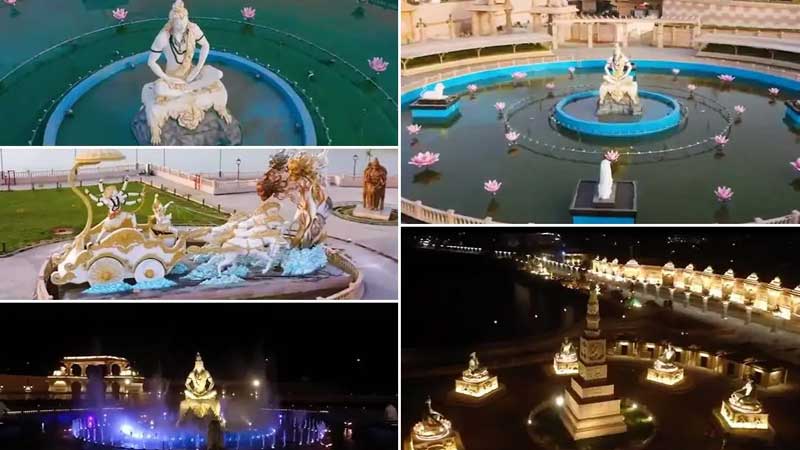|
Ujjain,Ujjain, located in Madhya Pradesh, is one of the
oldest and holiest cities in India, renowned for its rich history,
religious significance, and as one of the seven sacred cities of
Hinduism. It is famously known for the Mahakaleshwar Temple, one of the
twelve Jyotirlingas dedicated to Lord Shiva. Ujjain also plays a
significant role in the Kumbh Mela, which is held every 12 years. With
its spiritual ambiance, historical architecture, and vibrant cultural
festivals, Ujjain is a must-visit destination for pilgrims and history
enthusiasts.

It is a very holy city for the Hindus, a site for the
triennial Kumbh mela. There are many great mythological
legend about Ujjain city. Apart from mythological legends, the city has
a long distinguished history. It was governed by the likes of
Vikramaditya and Ashoka. Kalidas wrote his souls stirring poetry
here.
Today, Ujjain represents an interesting blend of an age old
legacy and the modern day lifestyle.
|
|
Ujjain, known as Avanti in ancient times, was once the capital of the
great emperor Chandragupta II of the Gupta dynasty. It has been a center
of learning and culture since ancient times, with scholars like Kalidasa
and Varahamihira being associated with the city. Ujjain has been a key
city for religious, astronomical, and educational purposes throughout
Indian history. The city has witnessed several dynasties, from the
Mauryas to the Marathas, who contributed to its spiritual and cultural
legacy. Today, it remains one of the holiest cities for Hindus, drawing
millions of pilgrims each year.
|
|
Omkareshwar:
Situated about 140 km from Ujjain, Omkareshwar is another Jyotirlinga temple on an island in the Narmada River.
The Mahakaleshwar temple at Ujjain is located near a lake; it has five
levels, one of which is underground.The temple itself is located in a
spacious courtyard surrounded by massive walls. The shikhara is adorned
with sculptural finery. Brass lamps light the way to the underground
sanctum. It is believed that prasada offered here to the deity can be
re-offered unlike all other shrines.
Bade Ganeshji ka Mandir :
There is a sculptured image of Lord Ganesh in this temple, close to the
tank near Mahakaleshwar.This temple situated above the tank near the
Mahakaleshwar temple, enshrines a huge artistic sculpture of Ganesh, the
son of Shiva. An idol of this size and beauty is rarely to be found. The
middle of the temple is adorned by an idol of the pancha-mukhi (five
faced) Hanuman. There is provision for learning of Sanskrit and
Astrology in the temple.
This temple situated above the tank near
the Mahakaleshwar temple, enshrines a huge artistic sculpture of Ganesh,
the son of Shiva. An idol of this size and beauty is rarely to be found.
The middle of the temple is adorned by an idol of the pancha-mukhi (five
faced) Hanuman. There is provision for learning of Sanskrit and
Astrology in the temple.
GadKalika:
The deity in this temple is believed to have worshipped by Kalidasa.
Renovated in 7 AD by the Emperor Harshavardhana, it was restored yet
again in the Parmar and, in modern times, by the erstwhile Gwalior
State.
Navgraha ka Mandir (Triveni):
Situated on the Triveni Ghat of Shipra, this temple is dedicated to the
nine planets.Situated on the Triveni Ghat of the Shipra, the temple is
located away from the old site of Ujjaini town. It is dedicated to the
nine planets, attracts large crowds on new moon days falling on
Saturdays. Its religious importance has increased in recent years though
there is no known reference to it in the ancient texts.
Bhartrihari Caves:
These caves are situated just above the bank of the Shipra near the
temple of Gadkalika. According to popular tradition, this is the spot
where Bhartrihari, who is said to have been the step brother of
Vikramaditya, lived and meditated after renouncing worldly life. He is
believed to have been a great scholar and poet. His famous works,
Shringarshatak, Vairagyashatak, and Nitishatak, are known for the
exquisite use of the Sanskrit meter.
Observatory:
Ujjain enjoyed a position of considerable importance in the field of
astronomy. Great works on astronomy such as the Surya Siddhanta and the
Panch Siddhanta were written in Ujjain. According to Indian astronomers,
the Tropic of Cancer is supposed to pass through Ujjain. It is also the
fist meridian of longitude of the Hindu geographers. From about the 4th
century BC, Ujjain enjoyed the reputation of being India's Greenwich.
The observatory extant today was built by Raja Jai Singh (1686-1743),
who was a great scholar. He translated the works of Ptolemy and Euclid
into Sanskrit from Arabic. Of the many observatories built by him at
Jaipur, Delhi, Varanasi, Mathura, and Ujjain, the one at Ujjain is still
in use actively. Astronomical studies are conducted through the
Department of Education and the ephemeris is published every year. There
is a small planetarium and a telescope to observe the moon, Mars,
Jupiter and their satellites. The observatory is also used for weather
forecasts
Maheshwar:
A beautiful town located on the banks of the Narmada River, about 140 km away, known for its handwoven Maheshwari sarees and historical significance.
Kalidasa Academia:
This academy was set up in Ujjain by the Government of Madhya Pradesh to
immortalize the memory of the great poet dramatist-Kalidasa, and to
create a multi-disciplinary institution to project the genius of the
entire classical tradition, with Kalidasa as the apex, enable research
and study in Sanskrit classical and traditional performing arts, and
facilitate its adaptation for contemporary stage in different cultural
settings and language groups. The Academy complex consists of a theatre,
museum, library, lecture and seminary halls, mini stage for rehearsals,
research facilities for scholars, and a large open air theater
Sandipani Ashram:
|